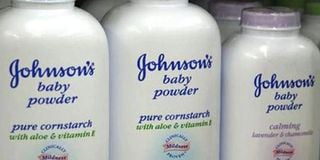Johnson & Johnson to change ingredients in cancer-linked product

Images of Johnson Johnson powder. Some countries banned the use of Johnson powder two years ago, citing health risks.
Though some countries banned the use of Johnson & Johnson (J&J) powder two years ago, citing health risks, the products are still available on Kenyan supermarket shelves.
Johnson’s Baby Powder and Shower to Shower are some of the products made by the company and can be found in supermarkets and beauty shops.
Baby powder is used to prevent nappy and heat rash. Some women also use it for genital hygiene to absorb odour and moisture.
In 2016, the popular baby powder was linked to ovarian cancer, and J&J was ordered to pay out $4.7 billion (Sh561 billion at current exchange rates) to 22 women who had claimed that asbestos in the company's talcum powder products caused them to develop ovarian cancer.
Talcum powder
After the court ruling, most countries, including the United States stopped using the product in 2020, but it is still being used in Kenya.
The product has been at the centre of tens of thousands of lawsuits filed by customers.
On Thursday, J&J released a statement clarifying that it is shifting from talcum powder ingredients to cornstarch in all the baby powder it sells around the world.
It said it has started producing cornstarch and that by 2023 all the talc baby powder will be out of the market.
It said it is already selling baby powder using cornstarch in some countries around the world, though it is not easy to tell, as the new ingredients are not indicated on bottles.
Talc or talcum powder is a component in beauty products made of magnesium, silicon and oxygen. It is also known to contain traces of asbestos, a substance that causes cancer.
J&J announced that the decision to move to cornstarch was part of a continuous evaluation of its portfolio and would help simplify its product offerings and meet “evolving global trends”.
It also reiterated its position on the safety of baby powder, saying: “We stand firmly behind the decades of independent scientific analysis by medical experts around the world that confirms talc-based Johnson’s Baby Powder is safe, does not contain asbestos, and does not cause cancer.”
Even though the company maintains that the product is safe, evidence on the safety of talc is not conclusive. The International Agency for Research on Cancer, which is part of the World Health Organization, classifies talc as “possibly carcinogenic”.
J&J’s decision to use cornstarch is understandable, said Alex Scranton, director of science and research at the environmental advocacy group Women’s Voices for the Earth.
Easy to obtain
“Cornstarch was inexpensive, easy to obtain, and free from talc’s ‘toxic profile’ and concerns about asbestos contamination,” said Ms Scranton, who was part of a campaign to pressure J&J to withdraw the products from shelves worldwide.
But a large study published in the Journal of the American Medical Association (JAMA) found no link between ovarian cancer and the use of talcum powder in the genital area, citing data from more than 250,000 women.
In the study led by Katie O'Brien of the National Institute of Environmental Health Sciences, researchers synthesised data from 1987 to 2017 and found that among the 252,745 women followed for a median period of 11.2 years, 2,168 developed ovarian cancer.
No statistically significant association was found when comparing women who had used powder and those who had not. Nor was any significant link found to frequency or length of use.



